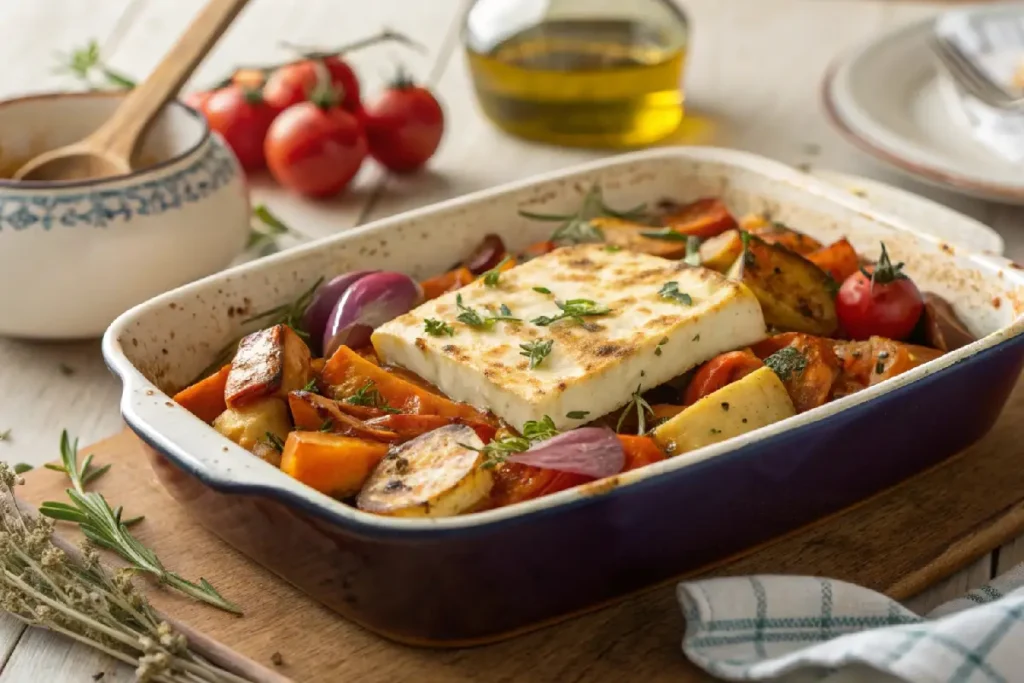Are you looking for a dish that’s packed with flavor and inspired by Mediterranean classics? Try this delightful feta vegetable bake. This article explores its background, must-have ingredients, and tips to customize it to your taste. You’ll also find step-by-step guidance, nutritional benefits, and answers to frequently asked questions so you can master this recipe at home.
Understanding the Feta Vegetable Bake
Defining the Dish and Its Mediterranean Roots
The feta vegetable bake originates from the Mediterranean, a region known for fresh produce and savory cheeses. Its star ingredient, feta cheese, adds a tangy punch to vegetables like zucchini, tomatoes, and bell peppers. This dish reflects the essence of Mediterranean cooking: simplicity, seasonality, and healthfulness.
With just a handful of vegetables, olive oil, fresh herbs, and feta, you can create a flavorful meal. It’s comforting food that appeals to everyone—from busy families to adventurous foodies craving global flavors.
Why Feta Cheese Elevates This Baked Recipe
Feta cheese brings a sharp, tangy flavor that pairs perfectly with roasted vegetables. When baked, it develops a velvety texture while retaining its signature salty zing. This balance enhances the sweetness of roasted zucchini, bell peppers, and onions. Feta also melts slightly, coating the vegetables and tying the dish together. Its bold flavor and creamy texture make this savory cheese and vegetable medley unforgettable.
History and Origins of the Feta Vegetable Bake

Influence of Greek Cuisine and Traditions
The feta vegetable bake has deep roots in Greek culinary history. For centuries, Greek households have used tangy goat or sheep’s milk cheese with fresh produce like tomatoes and peppers. These ingredients, grown in nutrient-rich soils, are central to many Greek dishes. However, this casserole-style preparation is uniquely Mediterranean.
Home cooks have passed these techniques through generations, often adding their own flair. Many include local herbs like oregano or thyme to enhance the flavor. Even today, regions in Greece feature their own versions of Greek-style baked vegetables, demonstrating its lasting significance.
Evolving Popularity and Culinary Adaptations
Over time, the feta vegetable bake has gained popularity far beyond Greece. Global travel and the demand for healthy meals made it a favorite worldwide. Mediterranean-inspired restaurants now serve variations of this savory cheese and vegetable medley, and creative cooks have added ingredients like artichokes or extra roasted vegetables to personalize it.
The rise of plant-based diets and the need for quick weeknight meals have also boosted its appeal. Its simple preparation, low-carb potential, and vegetarian-friendly nature make it a go-to recipe. Today, this timeless dish is featured in cooking magazines, blogs, and kitchens worldwide, proving its versatility and charm.
Craving more comfort food? Dive into our delicious Chicken Pot Pie Twice Baked Potatoes recipe and discover how to create the ultimate cozy dinner!
Key Ingredients for a Perfect Feta Veggie Casserole
Selecting the Ideal Vegetables
The backbone of any feta vegetable bake lies in its bounty of fresh produce. Most often, you’ll see tomatoes, bell peppers, and zucchini stealing the spotlight. However, carrots, eggplant, or even mushrooms can make stellar appearances too. Because each vegetable brings its own flavor and texture, many cooks like blending different kinds for a richer taste. For instance, eggplant’s earthy bite offsets the sweetness of roasted tomatoes, while red onions contribute a subtle caramelized note.
Moreover, focusing on quality is essential. Whenever possible, opt for summer garden vegetables if they’re in season, as this ensures optimal freshness. Additionally, washing and cutting the vegetables evenly means each piece roasts at the same rate. In turn, you’ll achieve uniformly cooked veggies that melt in your mouth alongside the crumbled feta topping.
Choosing High-Quality Feta Cheese and Seasonings
Another key factor in mastering a Greek-style baked vegetables dish is selecting top-tier feta. Although cow’s milk feta is widely available, experts and purists often suggest true Greek feta made from sheep’s or goat’s milk. This choice imparts a sharper, tangier taste that pairs well with the roasted veggies. Also, blending in complementary herbs, such as basil or thyme, lends depth to the overall flavor.
To underscore the traditional flavors, remember to add a mild sprinkling of salt—though be mindful that feta is naturally salty. Then, a drizzle of high-quality olive oil helps lock in moisture without making the dish soggy. Finally, be sure to layer your veggies properly, so each can soak up the mouthwatering juices. By choosing your ingredients with care, you’ll craft an irresistible savory cheese and vegetable medley that appeals to everyone at your table.
If you loved the idea of a feta vegetable bake, you won’t want to miss our Chicken Pot Pie Baked Potatoes! Click to explore this hearty twist on a classic!
How to Make a Classic Feta Vegetable Bake

Preparing and Chopping the Vegetables for Best Results
Before you dive into cooking, gather your colorful assortment of ingredients for this feta vegetable bake. Interestingly, many cooking experts emphasize the importance of structure and clarity in recipes to ensure they’re easy to follow, much like preparing an organized speech. Consequently, begin by selecting fresh tomatoes, bell peppers, zucchini, and onions, then wash them thoroughly under cool water. Afterward, remove seeds or stems as necessary, and chop everything into uniform pieces. This step allows the veggies to bake evenly and ensures no ingredient overcooks.
Meanwhile, place the prepared vegetables in a large mixing bowl. Toss them gently with a few tablespoons of high-quality extra virgin olive oil, making sure every bit shines with a light coat. Then, sprinkle in your chosen herbs—perhaps crisp oregano, fragrant basil, or thyme—to add a subtle yet distinct flavor. By seasoning your vegetables early, you’ll encourage the oven-roasted tomatoes and other produce to develop deeper tastes during baking.
Steps to Layer, Season, and Bake for Optimum Flavor
Next, reach for a trusty casserole dish. Arrange the vegetables in a single layer, avoiding overcrowding. Afterward, crumble your tangy feta cheese generously on top. Remember, crumbled feta topping is the heart of this Greek-style baked vegetables recipe, so feel free to indulge.
Furthermore, preheat your oven to about 375°F (190°C), then slide the dish onto the middle rack. Keep an eye on it after about 25 minutes, because cooking times can vary depending on your oven’s heat distribution. In most cases, the cheese will begin to brown slightly around the edges, signaling that the vegetables underneath are roasting happily. If you’d like an even crispier finish, switch your oven to broil in the last few minutes, but watch carefully to avoid burning.
Once everything turns tender and golden, remove the dish and bask in that delicious aroma. The savory cheese and vegetable medley should look lightly bubbly, with roasted zucchini, peppers, and tomatoes blending beautifully into a harmony of flavors. Let it cool briefly before serving, so no one scorches their tongue. If you’re craving more aromatic flair, sprinkle extra chopped herbs or a drizzle of olive oil just before bringing this stunning meal to the table.
Love the flavors of a feta vegetable bake? Discover our quick and easy guide to Baked Feta with Vegetables for another delicious twist!
Creative Variations of Feta Vegetable Bake

Adding Extra Protein with Chicken, Tofu, or Beans
Although the feta vegetable bake is scrumptious in its classic form, you can easily customize it with added proteins. For instance, try slicing some chicken breast into strips, lightly seasoning them with salt and pepper, and adding them to your vegetable blend before baking. The juices from the chicken will mingle with the roasted peppers and onions, producing an even richer flavor. If you prefer a plant-based option, swap in chunks of firm tofu, marinated in soy sauce or simple herbs. Protein-packed beans—like chickpeas—also provide a hearty meatless twist that pairs surprisingly well with warm, bubbling cheese.
Moreover, these protein options add dimension to your dish, allowing you to elevate the comforting Mediterranean-inspired casserole into a substantial main course that satisfies diverse dietary needs. After all, variety keeps home-cooked meals appealing night after night.
Vegetarian and Vegan-Friendly Twists (Using Dairy-Free Feta Alternatives)
If you’re aiming to accommodate guests who avoid dairy, consider experimenting with dairy-free feta alternatives. Several brands now offer convincing plant-based cheeses that still achieve a crumbly, salty profile. To balance the slightly different texture of vegan cheese, you might add extra vegetables or use a thicker tomato sauce to help bind everything together. Because dairy-free cheeses often brown faster than regular feta, keep an eye on your bake, particularly in the final minutes.
Additionally, piling on more herbs—like fresh basil, parsley, or dill—sparks color and freshness that can heighten your casserole’s flavor. You can mix and match extra veggies, such as roasted eggplant or mushrooms, to introduce more variety. Indeed, feel free to treat each ingredient like a paint stroke on your culinary canvas. When finished, your vegan version of this feta vegetable bake won’t merely satisfy your plant-based crowd; it might even convert a few skeptics who realize that healthy, low-carb recipe options can also bring full flavor.
If you enjoyed the feta vegetable bake, you’ll adore our Sheet Pan Feta Pasta! Click to explore this simple yet flavorful dish that’s perfect for busy nights!
Serving Suggestions and Meal Pairings for a Feta Vegetable Bake
Ideal Side Dishes to Complement the Bake
When you’re plating your feta vegetable bake, choosing the right sides can truly bring out its bold Mediterranean character. For instance, a simple spinach salad drizzled with lemon vinaigrette will offer a crisp contrast to the cheesy, roasted zucchini and peppers. Moreover, soft, warm pita bread can help soak up every last drop of that savory juice. If you crave a more hearty companion, consider a portion of roasted potatoes or a small bowl of lentil soup.
Additionally, think about textures that enhance your dish. Fluffy couscous or quinoa blends well with the tanginess of feta cheese, while grilled asparagus or sautéed spinach can provide extra color. Because the vegetables in this bake develop sweet, caramelized flavors, pairing with tart or garlicky sides works especially well. Ultimately, a proper side can elevate your whole meal, turning this Mediterranean-inspired casserole into a memorable feast.
Presentation Tips for a Crowd-Pleasing Table
Beyond flavor, presentation adds a certain flair. First, choose a colorful serving platter or a rustic baking dish that shows off the bright vegetables and crumbled feta topping. Next, garnish your dish with fresh herbs—like basil or parsley—to lend a burst of green.
Furthermore, keep clean slices of lemon nearby to help guests customize their plates with a hint of zesty flavor. By paying attention to the details, you’ll ensure that your feta vegetable bake stands out on any celebration table, stealing the limelight and tempting everyone to dig in.
Nutritional Benefits of a Feta Vegetable Bake
Health Perks of Vitamin-Rich Vegetables and Feta Cheese
This feta vegetable bake doesn’t just taste delicious; it also boasts nutrients essential for a healthy lifestyle. Of course, the blend of garden-fresh produce—like tomatoes, peppers, and zucchini—delivers ample vitamins, antioxidants, and fiber. Meanwhile, feta cheese contains bone-building calcium and protein, which can help keep you feeling satisfied. Because this dish is baked rather than fried, extra oil is minimal, making your overall meal lighter.
Additionally, herbs such as oregano or basil contribute potent antioxidants, plus a refreshing scent. The result is a savory cheese and vegetable medley that provides vitamins A, C, and K, among others. If you want further nutritional variety, add high-protein foods like beans, lentils, or lean chicken.
Dietary Considerations: Sodium, Fat, and Alternative Cheese Options
Although the feta vegetable bake offers plenty of perks, be mindful of sodium content. Feta cheese, by nature, contains salt, so balance the recipe by limiting extra salt elsewhere. Moreover, consider using reduced-fat cheeses if you’re watching your calorie intake.
Keep a close eye on portion sizes, since any dish—no matter how nutritious—can contribute to weight gain if you overdo it. Lastly, for those who avoid dairy, vegan-friendly feta alternatives made from nuts or coconut-based products exist.
These still deliver a crumbly, salty flavor while lowering saturated fat content. Ultimately, moderation and smart ingredient choices can keep this Mediterranean-inspired casserole a healthful staple in your meal rotation.
Craving more cheesy goodness? Dive into our Baked Feta Pasta recipe, where creamy feta meets juicy cherry tomatoes for a mouthwatering meal
FAQs:
Feta cheese can be part of a balanced diet because it offers calcium and protein. Moreover, it provides a tangy taste that complements vibrant vegetables. However, keep in mind that feta contains higher sodium levels than some other cheeses, so moderation is key.
Many people love pairing feta with tomatoes, peppers, zucchini, and mushrooms. In fact, these vegetables tend to caramelize nicely when baked, highlighting feta’s salty bite. Additionally, eggplant, red onions, or olives can offer layers of subtle bitterness or sweetness.
First, allow your leftovers to cool. Then, place them in an airtight container before storing in the refrigerator. Ideally, consume within three to four days. Additionally, warming up your bake in the oven helps recapture its original texture. Avoid microwaving it for too long, as cheese can turn rubbery, losing its creamy appeal.
Absolutely! Vegan feta made from nuts or coconut-based products can deliver a similar crumble and salty flavor. Furthermore, dairy-free cheeses often brown quickly, so watch your baking times closely. If you’re trying to keep sodium in check, opt for a low-salt variety.
Because this dish bursts with unique flavors, mild sides complement it best. For instance, roasted potatoes, a crisp green salad, or warm pita bread can help balance feta’s tang. Moreover, lemony couscous or quinoa amplifies the zesty aspect of the bake. Overall, pair your veggies and cheese with simple dishes that highlight the vibrant produce.
Conclusion
In conclusion, preparing a feta vegetable bake at home is both simple and satisfying. Moreover, the combined tangy cheese and sweet vegetables form a flavorsome synergy that suits busy families and enthusiasts craving a wholesome comfort food. Furthermore, relying on fresh, high-quality produce ensures a nourishing meal full of vitamins and minerals.
Because the recipe is versatile, you can easily add proteins or switch to vegan cheese for plant-based alternatives. Ultimately, serving it with crunchy salad or soft bread yields a delicious and balanced spread. Embrace the art of home cooking and share this Mediterranean-inspired delight with your loved ones.





